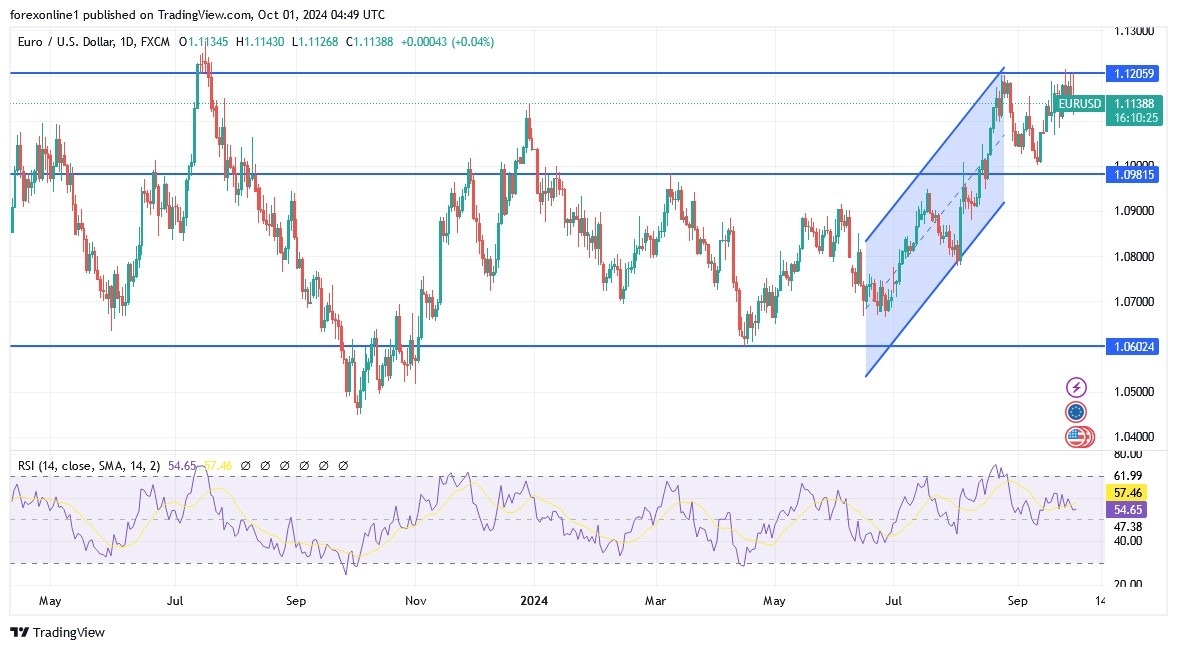- At the beginning of this important week's trading, the euro traded near 1.118 US dollars as investors prepare for a busy week of economic data from the eurozone.
- According to the results of the economic calendar, preliminary figures are expected to show that inflation in the eurozone has fallen to the European Central Bank's target of 2%, its lowest level since June 2021.
- Inflation in Germany is expected to fall to 1.7%, its lowest level since February 2021, while inflation in Italy may fall to 0.8%.
- The PMI data is likely to confirm the ongoing weakness, with the manufacturing sector in Spain stagnating and sharper declines in Italy and Switzerland. Also, the services sector in Spain is expected to expand at a slower pace.

Likewise, European Central Bank President Christine Lagarde will address the European Parliament. Last week, inflation in France and Spain fell more than expected, fueling speculation that the ECB may accelerate its rate-cutting cycle, having already cut rates twice this year. Concurrently, financial markets are now pricing in a potential rate cut on October 17.
Top Forex Brokers
EUR/USD Forecast for this week:
According to Forex trading, the euro is facing a setback this week despite growing speculation that the ECB will accelerate its rate-cutting pace. According to reliable trading platforms, the euro/dollar exchange rate hit a new 2024 high of 1.1212 last week and has been falling since then, with charts indicating that it is gaining energy before breaking higher.
Indeed, the technical setup is constructive and calls for further gains this week, but we are tired of betting on further upside at this point given the calendar risks that fill the path ahead. In this regard, the Forex analysts at Credit Agricole say: “Investors are nervous ahead of several Fed speakers this week as well as the release of US ISM and labor market data.”
EUR/USD Technical analysis and forecast:
For now, the 1.1212 barrier remains the upside target, and we see it easily achievable if US data comes in below expectations this week. However, if the cards do not fall in the EUR bulls’ favor, a pullback to the 1.1083 level is likely, where we believe buying interest will emerge. According to the chart attached, this is the 23.6% Fibonacci retracement of the 2024 high and has already proven its value as a predictive level. Technically, The euro continues to trade near recent highs against the US dollar but is increasingly undermined by expectations of aggressive interest rate cuts from the European Central Bank (ECB) that have intensified following last week’s massive rate cut by the Federal Reserve.
In the eurozone, the ECB’s thinking will be influenced by September inflation figures, with Germany due to release data on Monday ahead of the full eurozone data on Tuesday, with the eurozone’s core CPI expected to fall below the ECB’s 2.0% target, falling to 1.9%. Earlier this week’s French and Spanish figures were both well below expectations, raising the odds of another ECB rate cut as early as October to 80%.
As such, the market is already leaning towards the dovish side of expectations, limiting the likelihood of a major market reaction (i.e. a fall in the euro versus the dollar). Analysts say the eurozone inflation reading for September is of paramount importance for the ECB’s monetary policy decision on October 17. If core and services inflation remain elevated at 2.8% y/y and 4.2% y/y respectively, the ECB may focus on cutting them even though some European economies, particularly Germany, are in dire need of more supportive monetary policy.
ECB Governing Council members have maintained that caution in cutting rates is warranted, but Nomura analyst George Buckley says this week will be full of speeches from ECB policymakers, which will be “crucial in determining how realistic the ECB is in its belief that the pace of cuts will be faster.”
ECB President Christine Lagarde will be kept an eye on, and markets will want her to address the prospects of an October rate cut given the poor German data, weak eurozone PMIs in September and weak inflation figures. Overall, Lagarde may choose to maintain the view that the ECB will want to see more data before cutting rates again, underscoring the ECB’s clear desire to cut rates again only in December.
Furthermore, the data we do have sends some clear signals: Germany is in dire need of rate cuts from the ECB and inflation is at risk of falling faster than the ECB expects.
Federal Reserve talk and US payrolls
Nevertheless, the US dollar remains the dominant player in the Euro/Dollar pair. With this in mind, keep an eye on US PMI survey data on Tuesday and speeches by FOMC members Cook, Collins, Barkin, and Bostic. Bowman and Barkin will speak on Wednesday. More US PMI figures (covering the services sector) are due on Thursday, which will keep markets on edge ahead of the week's highlight, the non-farm payrolls release on Friday.
A figure of 144,000 is expected here. The basic rule is that any number slightly below that would indicate the need for more cuts at the Federal Reserve and maintain a risk-on mood globally and for the pound. Moreover, a significant decline could backfire as it could signal that the economy may be slipping into recession. Therefore, if the numbers deliver a big upside surprise, markets will certainly fall as investors race to bet that the Federal Reserve will slow the pace of cuts. Thus, this would likely lower interest rates. This is likely to lead to a dollar recovery, prompting a retest of the technical support level at 1.1083.
Ready to trade our EUR/USD daily forecast? We’ve shortlisted the best forex broker list for you to check out.
